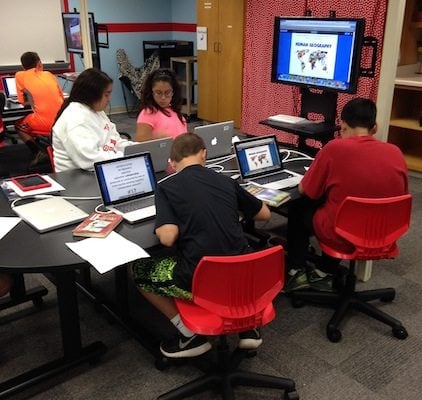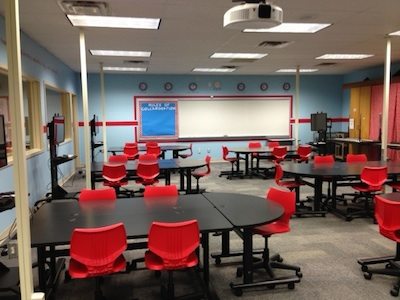Mary Moore Elementary librarian uses grant to start collaborative learning lab

It’s not just technology that powers Mary Moore Elementary’s collaborative learning lab, a resource funded by a Technology Through Innovation grant. It’s also fueled by the passion and vision of the school’s librarian, Carrie Boden. She believes the lab – her “baby” – offers students the kind of technology experience and collaborative opportunities that will prepare them for the real world.
The room that houses the collaborative learning lab used to be a traditional computer lab. But now it has six work stations. Each station has a large monitor at the head of a table and five chairs. The room also includes a cart containing enough MacBook laptop computers for each student to use. As students sit at the tables, they plug their computers into the large monitor. With just the touch of a button, they can display any of their MacBook screens on the monitor.
While the technology is key, so is the furniture. Flexible tables and rolling chairs are easy to move and rearrange, allowing for easy collaboration and a variety of activities.
“I love the furniture,” Boden said.
She loves when she sees a student roll from one table to the next, working with others, fully engaged in the material and project.
“That’s awesome when that happens,” she said.
Boden, who has taught in the AISD for 27 years and has been the librarian at Moore for 15, and other Moore teachers developed the concept for the lab in their application for a Transformation Through Innovation grant. The grant, which funded the lab, is itself funded by the 2014 Bond package. The bond includes $1 million in each of its five years of implementation to be awarded to AISD teachers and schools who develop innovative learning environments for their students through technology. The grant money’s purpose is to facilitate innovative teaching methods that will truly transform the classroom and learning environment. It’s about using technology to teach in a new, more effective way. In 2013-2014, 12 grants were awarded to 13 campuses, and last year, 28 grants were given to 30 campuses, impacting thousands of students. (Read about last year’s winners.)
While the lab is certainly unique, Boden views its mission as essential. Teaching technology skills and collaboration has become crucial.

“That’s the world they live in,” Boden said about the students who are growing up in a technology-saturated environment.
Technology skills will be imperative for success both in and outside of the classroom.
“They need to know how to use it ethically and creatively,” she said.
And “collaboration is a life skill, preparing them for the workforce,” she added.
The lab provides an ideal space and tools to teach these skills and is available to any teacher. Boden most often uses it for her research classes. Right now she has her fourth-grade classes researching the regions of Texas. They have been broken into groups and each must prepare a presentation about a particular region of Texas using Google Slides. Each student is responsible for one slide, but as part of the group presentation. They must work together to create a cohesive whole, critiquing each other and offering feedback. The tables and monitors in the lab allow them the perfect space to do their work.
Another group project Boden has given students is to build a website about animals from a specific region. She teaches the students about the components of a good, functional website and then assigns groups to create their own using Weebly. They have to develop a consistent, functional design, along with the content.
“They learn to critique rather than criticize,” she said, a skill that will serve them well in all areas of life.
The current uses for the lab are exciting, but Boden believes the space and tools are capable of much more. They’re still just building right now, she explained. She hopes a recent competition in November with three other schools from three other districts is a harbinger of things to come. Moore’s students participated in a timed competition to build a structure – that would remain standing – out of spaghetti and marshmallows. The directions were posted on the large monitors while the students built their creations in the lab. Throughout the process they were able to interact in real time with the students at the other schools who were busy building their structures. (See a tweet from that day with several photos.)
Boden has other ideas as well. She is also looking into adding coding activities. She wants classes to Skype with authors in what would feel like a conference environment. And she has plans to use a green screen in the lab for a collaborative film project to create public service announcements.
Teaching these technology and collaboration skills is about preparing students for their future. They should not be “extra,” Boden insisted. A paradigm shift is necessary, in which technology and collaboration are part of education – infused in education – and not just considered add-ons or extra activities when there is time. Thanks to the Transformation Through Innovation grant and dedicated teachers like Boden, technology and collaboration are indeed becoming a regular part of education for students at Mary Moore Elementary.
